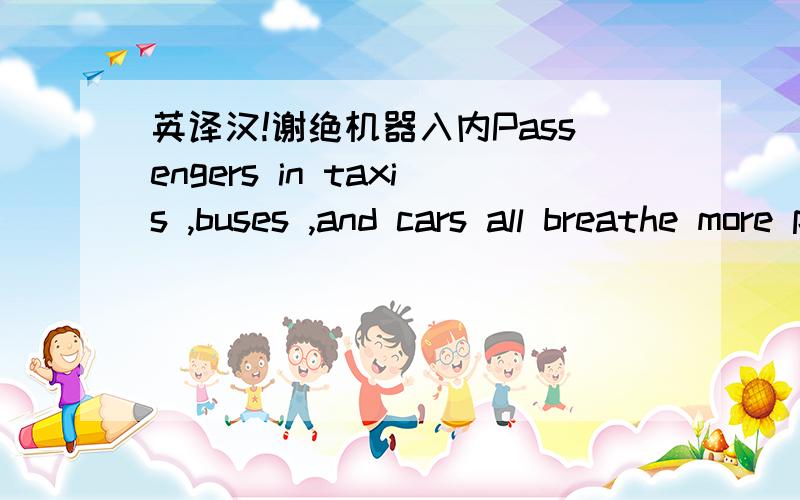英译汉!谢绝机器入内Passengers in taxis ,buses ,and cars all breathe more pollution than cyclists and pedestrians,a new study shows.Researchers measured levels of levels of ultra-fine(极细微的),traffic-produced pollution particles(粒子
来源:学生作业帮助网 编辑:作业帮 时间:2024/04/29 10:39:33

英译汉!谢绝机器入内Passengers in taxis ,buses ,and cars all breathe more pollution than cyclists and pedestrians,a new study shows.Researchers measured levels of levels of ultra-fine(极细微的),traffic-produced pollution particles(粒子
英译汉!谢绝机器入内
Passengers in taxis ,buses ,and cars all breathe more pollution than cyclists and pedestrians,a new study shows.Researchers measured levels of levels of ultra-fine(极细微的),traffic-produced pollution particles(粒子的) on busy London streets using a newly developed particle counter fitted with a video recorder.
The equipment allowed them to match particle levels with each of the five modes of transport.They also could identify what activities and behaviors lead to the highest exposures(暴露).On average,taxi passengers were exposed to just under100,000 and people in cars about 40,000.
Pedestrians and bicyclists,meanwhile ,were exposed to counts of just 5 ,000 and 8 ,000 ,respectively.Ultra-fine particles are so small that large amounts can be breathed in a single breath,after which they can settle in the lungs and damage cells.
Would the results hold true in New York City or elsewhere?We generally found that the trends such as pedestrians having the lowest exposures and the in-vehicle exposures being much higher to be common across different countries,” study co-author Surbjit Kaur of Imperial College London said,“However,the concentrations(浓度) do vary due to different local conditions,such as traffic,meteorology,building layout,and configuration.“
People sitting in a vehicle in the middle of heavy traffic are directly in the path of the pollutant source---other vehicle’ s mufflers.Pollution in cars is less than in other vehicles most likely because cars generally spend less time in traffic than taxis and buses,Also,private cars tend to be cleaner to begin with.
Bikers stick mostly to the outer edges of the street,where pollution levels are lower.People on the sidewalk are even further away.
英译汉!谢绝机器入内Passengers in taxis ,buses ,and cars all breathe more pollution than cyclists and pedestrians,a new study shows.Researchers measured levels of levels of ultra-fine(极细微的),traffic-produced pollution particles(粒子
研究人员利用一个配有录像机的最新发明的粒子计数器在伦敦闹区测量了诸多不同层次的、超细的、由交通导致的污染粒子.研究发现的士、巴士、小车乘客比骑自行车的人和行人吸入的污染要多.该设备允许研究人员与5类运输方式中的每一种方式进行粒子层次匹配.研究人员还可以识别出是什么活动和行为导致人们遭受的污染程度最高.平均而言,的士乘客遭受的污染粒子正好在10万单位以下,而小车里的乘客遭受污染粒子大约是4万单位.
同时,行人和骑自行车的人遭受的污染粒子正好分别是5000和8000单位.超细粒子太小了以致一次呼吸可以吸入大量粒子,然后粒子进入肺部破坏细胞.纽约或世界其他各地的研究结果也是如此吗?英国皇家学院的合作研究员Surbjit Kaur说:“我们普遍发现在其他各国有这么一种趋势,即行人遭受的粒子污染最少,而搭乘交通工具的人员同样遭受更高的粒子污染.但是粒子的浓度却因各地不同的条件如交通、气象学、建筑物布局、结构等而不尽相同.”高峰期搭乘交通工具的人们直接在污染物源头-即其他交通工具的消声器路径上.小车里的污染少于其他交通工具里的很可能是因为小车行驶的时间一般比的士和巴士较短;而且,私家车更干净.骑自行车的人大多喜欢走外道,而外道的空气污染又较低.人行道上的行人离主道就更远了.